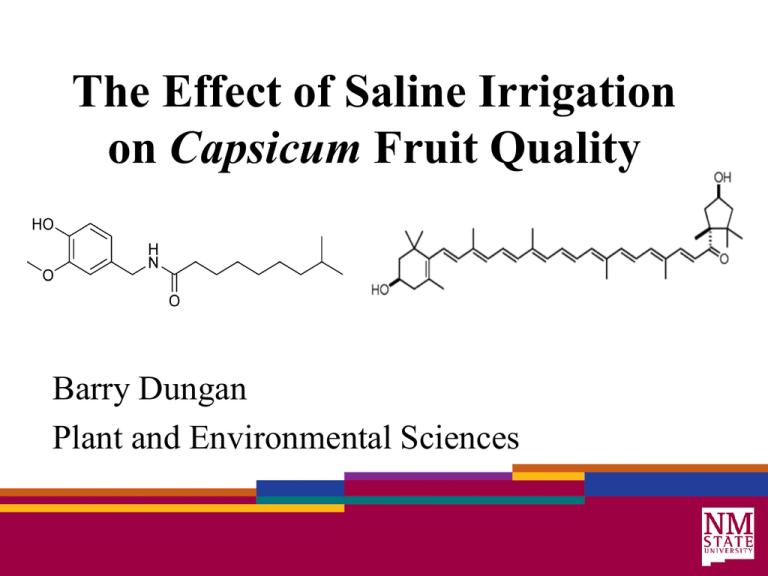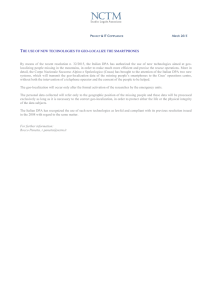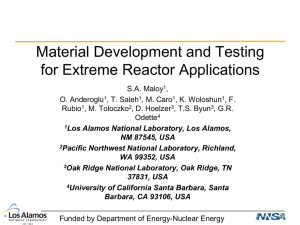Adopted Thesis - The Chile Pepper Institute
advertisement

The Effect of Saline Irrigation on Capsicum Fruit Quality Barry Dungan Plant and Environmental Sciences Chile Products •Chile is an versatile crop for New Mexico •Chile produces two commercially valuable secondary metabolites: Carotenoids extracted for oleoresin production. Color Capsaicinoids extracted for spices, medicinal creams, and pepper spray. Pungency New Mexico Agriculture Issues • Quality and abundance of water is an issue in New Mexico – semi-arid climate – Agriculture crops – Drought periods • Approximately ¾ of the groundwater in New Mexico is saline (Reynolds, 1962) • This study will compare the metabolite production in three chile cultivars irrigated with three different levels of saline water. Objectives •Determine the effect of saline irrigation on fruit quality traits in Capsicum species •Characterize the expression of genes on the capsaicinoid and carotenoid biosynthetic pathway Materials and Methods Takanotsume NuMex Garnet Early Jalapeno • Germinated in a growth chamber, transplanted to the greenhouse – 2 gallon pots – Metro Mix 360 soil Materials and Methods • Saline water treatments – Control (potable water) – 750 PPM/TDS – 1500 PPM/TDS • 1.5 L every other day • ~2 month period • Fruit/Flower development monitored by tagging Salt Profile • Water collected from Geothermal well AC19373 near the NMSU golf course. • 930 mg/L Na2SO4 • 105 mg/L KCl • 150 mg/L MgSO4 • 489 mg/L CaCO3 • pH 6.5-6.8 Data Collection • Upon harvest the fruit was grouped by age, weighed. • Half of the fruit was placed in a forced air oven for capsaicinoid and carotenoid analysis. • Half of the fruit was placed at -80° for RNA analysis. Metabolite Extraction • Capsaicinoids: – 1g dry material sonicated in isopropanol 30 minutes, vortexed • Carotenoids: – 2g dry material was sonicated in isopropanol 30 minutes – Saponified using Methanolic Potassium Hydroxide UPLC Chromatogram Ultra Pressure Liquid Chromatography was used to identify 5 carotenoids Peak A Peak B Peak C Peak D Peak E Capsanthin Capsorubin Zeaxanthin β-Cryptoxanthin β-Carotene HPLC Chromatogram A B High Pressure Liquid Chromatography was used to identify 2 major capsaicinoids Peak A Peak B Capsaicin Dihydrocapsaicin Accumulation of capsaicinoids in the fruit of Early Jalapeno 1500000 1250000 1000000 750000 500000 250000 0 SHU 1500 PPM TDS 750 PPM TDS Control 10 dpa 18-23 dpa 30-35 dpa 44-50 dpa Accumulation of capsaicinoids in the fruit of Takanotsume 700000 600000 500000 400000 300000 200000 100000 0 SHU Control 750 PPM TDS 1500 PPM TDS 10 dpa 18-23 dpa 30-35 dpa 44-50 dpa Total carotenoid accumulation in Takanotsume based on developmental 80,000.00 stage 70,000.00 60,000.00 50,000.00 40,000.00 30,000.00 20,000.00 10,000.00 Peak 0.00 Area 60 DPA Control 60 DPA 1500 PPM 45 DPA Control 45 DPA 1500 PPM Total carotenoid accumulation in Garnet based on developmental stage 80,000 70,000 60,000 50,000 40,000 30,000 20,000 10,000 Peak 0 Area 60 DPA Control 60 DPA 1500 PPM 45 DPA Control 45 DPA 1500 PPM 70,000 Total carotenoid accumulation in Garnet and Takanotsume 60,000 50,000 40,000 30,000 20,000 10,000 Peak Area 0 Garnet Control Garnet 1500 PPM/TDS Takanotsume Control Takanotsume 1500 PPM/TDS Results • The HPLC and UPLC results show that capsaicinoid content in Early Jalapeno was increased with salt stress. • Their was a neutral effect in both capsaicinoid and carotenoid accumulation in Takanotsume. • Garnet showed a decrease in carotenoid accumulation with salt stress. Discussion • Currently isolating RNA to characterize the gene expression for the capsaicinoid and carotenoid pathways. • The second replication for this experiment has been harvested and fruit analysis is underway. • Depending on the results, other cultivars may be tested. – Other salt concentrations or salt ratios may be tested. Acknowledgments • • • • • • • Dr. O’Connell Dr. Rich Richins Erin Fitzgerald Harvest Crew Omar Holguin S.W.A.T lab Chile Pepper Institute Reynolds, S.E., 1962, Twenty-fifth biennial report of the State Engineer of New Mexico for the 49th and 50th fiscal years July 1, 1960, to June 30, 1962: Albuquerque, The Valliant Company, p 193 Questions?







